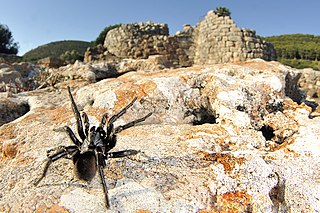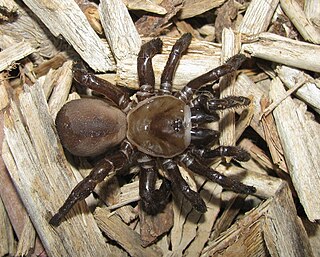
The wafer trapdoor spiders, family Cyrtaucheniidae, are a widespread family of spiders that lack the thorn-like spines on tarsi and metatarsi I and II found in true trapdoor spiders (Ctenizidae).

Crevice weaver spiders (Filistatidae) comprise cribellate spiders with features that have been regarded as "primitive" for araneomorph spiders. They are weavers of funnel or tube webs. The family contains 18 genera and more than 120 described species worldwide.

Hexathelidae is a family of mygalomorph spiders. It is one of a number of families and genera of spiders known as funnel-web spiders. In 2018, the family was substantially reduced in size by genera being moved to three separate families: Atracidae, Macrothelidae and Porrhothelidae. Atracidae includes the most venomous species formerly placed in Hexathelidae.

Anton Ausserer was an Austrian naturalist specialising in spiders. His father died when he was a youth, and he and his family suffered much economic hardship, but he was supported and encouraged by Camill Heller, professor of Zoology and Comparative Anatomy at the University of Innsbruck.

Idiopidae, also known as armored trapdoor spiders, is a family of mygalomorph spiders first described by Eugène Simon in 1889. They have a large body similar to tarantulas.

Barychelidae, also known as brushed trapdoor spiders, is a spider family with about 300 species in 42 genera. Most spiders in this family build trapdoor burrows. For example, the 20 millimetres (0.79 in) long Sipalolasma builds its burrow in rotted wood, with a hinged trapdoor at each end. The 10 millimetres (0.39 in) long Idioctis builds its burrow approximately 5 centimetres (2.0 in) deep, just below the high tide level, sealing the opening with a thin trapdoor.

Antrodiaetidae, also known as folding trapdoor spiders, is a small spider family related to atypical tarantulas. They are found almost exclusively in the western and midwestern United States, from California to Washington and east to the Appalachian mountains. Exceptions include Antrodiaetus roretzi and Antrodiaetus yesoensis, which are endemic to Japan and are considered relict species. It is likely that two separate vicariance events led to the evolution of these two species.

Macrothele is a genus of mygalomorph spiders in the family Macrothelidae, and was first described by A. Ausserer in 1871. It is the only genus in the family Macrothelidae, and most species occur in Asia, from India to Japan, and Java, with four found in Africa, and two in Europe. The name is derived from Ancient Greek μακρός ("makro-"), meaning "big", and θηλή ("thele"), referring to the spinnerets.

Antrodiaetus is a genus of American and Japanese folding trapdoor spiders first described by Anton Ausserer in 1871. The name is a combination of the Greek "antrodiaitos" (αντροδιαιτος), meaning "living in caves", "antron" (αντρον), meaning "cave", and "diaita (διαιτα), meaning "way of life, dwelling".
Cyclosternum is a genus of tarantulas that was first described by Anton Ausserer in 1871.
Cyrtocarenum is a genus of Balkan trapdoor spiders first described by Anton Ausserer in 1871. As of April 2019 it contains only two species found in Greece and Turkey: C. cunicularium and C. grajum.

Amblyocarenum nuragicus, or also Nuragic spider, is a spider in the family Nemesiidae. It is endemic to the Mediterranean island of Sardinia, where it is pretty much common to be found on the surface in the summer, and its scientific name pays homage to the Nuragic civilization. The body length ranges from 17 to 25 mm.

Chaetopelma is a genus of tarantulas that was first described by Anton Ausserer in 1871.
Ischnocolus is a genus of tarantulas that was first described by Anton Ausserer in 1871.

Hexathele is a genus of funnel-web spiders endemic to New Zealand that was first described by Anton Ausserer in 1871, though most others have been described by Raymond Robert Forster. Originally placed with the curtain web spiders, it was moved to the Hexathelidae in 1980.
Mygalarachne is a monotypic genus of Honduran tarantulas containing the single species, Mygalarachne brevipes. It was first described by Anton Ausserer in 1871, and is found in Honduras.
Brachythele is a genus of spiders in the family Nemesiidae. It was first described in 1871 by Ausserer. As of 2017, it contains 8 species from eastern Europe.

Halonoproctidae is a family of mygalomorph spiders, split off from the family Ctenizidae in 2018. Species in the family are widely distributed in North and Central America, Australasia, Asia, southern Europe and North Africa. One species is recorded from Venezuela in South America. They are relatively large, sombrely coloured spiders, that live in burrows with some kind of trapdoor.

Nemesia is a genus of mygalomorph spiders in the family Nemesiidae, first described by Jean Victoire Audouin in 1826.












